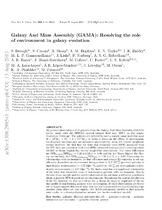Galaxy And Mass Assembly (GAMA): Resolving the role of environment in galaxy evolution
Abstract
We present observations of 18 galaxies from the Galaxy And Mass Assembly (GAMA)
survey made with the SPIRAL optical integral field unit (IFU) on the Anglo- Australian Telescope. The galaxies are selected to have a narrow range in stellar mass
(6 × 109M
< M∗
< 2 × 1010M
) in order to focus on the effects of environment.
Local galaxy environments are measured quantitatively using 5th nearest neighbour surface densities. We find that the total star formation rates (SFR) measured from the IFU data are consistent with total SFRs measured from aperture correcting either GAMA or Sloan Digital Sky Survey single-fibre observations. The mean differences are SFRGAMA/SFRIFU = 1.26 ± 0.23, σ = 0.90 and for the Sloan Digital Sky Sur- vey we similarly find SFRBrinchmann/SFRIFU = 1.34 ± 0.17, σ = 0.67. Examining the relationships with environment, we find off-centre and clumpy Hα emission is not sig- nificantly dependent on environment, being present in 2/7 (29+20 per cent) galaxies in high-density environments (> 0.77 Mpc−2), and 5/11 (45+15 per cent) galaxies in low-density environments (< 0.77 Mpc−2). We find a weak but not significant relationship
of the total star formation rates of star-forming galaxies with environment. Due to the size of our sample and the scatter observed we do not draw a definitive conclusion about a possible SFR dependence on environment. Examining the spatial distribution of the Hα emission, we find no evidence for a change in shape or amplitude of the ra- dial profile of star-forming galaxies with environment. If these observations are borne out in larger samples this would infer that any environment-driven star-formation sup- pression must either act very rapidly (the ‘infall-and-quench’ model) or that galaxies must evolve in a density-dependent manner (an ‘in-situ evolution’ model).

